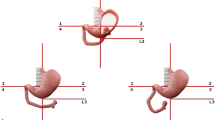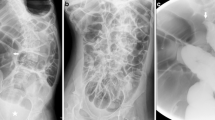Abstract
Background
Congenital pouch colon (CPC) is a rare form of high ano-rectal malformation (ARM) in which part of or the entire colon is replaced by a pouch with a fistula to the genito-urinary tract. According to the Saxena-Mathur classification CPC is divided into five types. Although plain abdominal radiographs are taken in infants with suspicion of CPC to detect large dilatation of the pouch, the determination of the type of CPC is made during surgical exploration. Since large variations in the length of normal colon are present in the various types, management strategy options can be determined only at the time of surgery.
Objective
The aim of this study was to review abdominal radiographs of children with congenital pouch colon (CPC) and evaluate their value in determining the type of CPC prior to surgical exploration to assist pre-operative planning.
Materials and methods
Over a 12-year period (1995–2007), CPC was documented in 80 children (52 boys and 28 girls, age range 1 day–9 years, median 2.4 days) and retrospective analysis of plain abdominal radiographs of 77 children at the time of presentation was performed. Radiographic findings were correlated with surgical findings.
Results
Of 77 children, 5 were excluded from the study since the pouch colon was perforated. The direction of the pouch apex was correlated with surgical findings to determine the CPC type (P < 0.0001, Fisher exact test). Type 1 (17/18) and type 2 CPC (18/18) were characterized by a single large pouch with the apex positioned in the left hypochondrium. In type 3 CPC (2/2) the pouch apex was directed towards the right hypochondrium. In type 4 CPC the apex of the pouch was directed towards the right hypochondrium (28/33); however in 5 children it was towards the left hypochondrium. In type 5 CPC (n = 1) the radiograph was inconclusive.
Conclusion
Plain abdominal radiographs have a predictive value in determining the type of CPC and obviating the need for an invertogram.








Similar content being viewed by others
References
Singh S, Pathak IC (1972) Short colon malformations with imperforate anus. Surgery 71:781–786
Rao KL, Menon P (2005) Congenital pouch colon associated with anorectal agenesis (pouch colon syndrome). Pediatr Surg Int 21:125–126
Singh A, Singh R, Singh A (1977) Short colon malformation with imperforate anus. Acta Pediatr Scand 66:589–594
Budhiraja S, Pandit SK, Rattan KN (1997) A report of 27 cases of congenital short colon with an imperforate anus: so called ‘pouch colon syndrome’. Trop Doct 27:217–220
Narasimha Rao KL, Yadav K, Mitra SK et al (1984) Congenital short colon with imperforate anus (pouch colon syndrome). Ann Pediatr Surg 1:159–67
Kalani BP, Sogani KC (1984) Short colon associated with anorectal agenesis: treatment by colonoraphy. Ann Pediatr Surg 1:83–85
Mathur P, Rana YP, Simlot A et al (2008) Congenital pouch colon with duplicate bladder exstrophy. J Pediatr Surg 43:E9–11
Chatterjee SK (2005) Colonic agenesis, pouch colon, rectal ectasia and shared colon. In: Chatterjee SK (ed) Surgery pediatric anorectal malformations. Viva Books, Kolkata, pp 175–189
Gupta DK, Sharma S (2007) Congenital pouch colon—then and now. J Indian Assoc Pediatr Surg 12:5–12
Stephans FD, Smith ED, Paoul NW (eds) (1988) Anorectal malformations in children: update 1988 Birth defects original articles series AR Liss, New York vol 24 no.4
Holschneider A, Hutson J, Pena A et al (2005) Preliminary report on the International Conference for the Development of Standards for the Treatment of Anorectal Malformations. J Pediatr Surg 40:1521–1526
Saxena AK, Mathur P (2008) Classification of congenital pouch colon based on anatomic morphology. Int J Colorectal Dis 23:635–639
Mathur P, Saxena AK, Simlot A (2009) Management of congenital pouch colon based on the Saxena-Mathur classification. J Pediatr Surg 44:962–966
Singal AK, Bhatnagar V (2006) Colostomy prolapse and hernia following window colostomy in congenital pouch colon. Pediatr Surg Int 22:459–461
Bhat NA (2007) Congenital pouch colon syndrome: a report of 17 cases. Ann Saudi Med 27:79–83
Herman TE, Coplen D, Skinner M (2000) Congenital short colon with imperforate anus (pouch colon). Report of a case. Pediatr Radiol 30:243–246
Mathur P, Prabhu K, Jindal D (2002) Unusual presentations of pouch colon. J Pediatr Surg 37:1351–1353
Res JR, Redo SF (1968) Anomalies of intestinal rotation and fixation. Am J Surg 116:834–841
Balthazar EJ (1977) Congenital positional anomalies of the colon: radiographic diagnosis and clinical implications. II. Abnormalities of fixation. Gastrointest Radiol 18:49–56
Stauffer UG, Herrmann P (1980) Comparison of late results in patients with corrected intestinal malrotation with and without fixation of the mesentery. J Pediatr Surg 15:9–12
Yau WM, Makhlouf GM (1975) Comparison of transport mechanisms in isolated ascending and descending rat colon. Am J Physiol 228:191–195
Park JH, Rhee PL, Lee JH et al (2006) Segmental heterogeneity of electrogenic secretions in human ascending colon and rectum. Int J Colorectal Dis 21:357–364
Lee L, Hossain M, Wang Y et al (2004) Absorption of rivastigmine from different regions of the gastrointestinal tract in humans. J Clin Pharmacol 44:599–604
Araki K, Furuya Y, Kobayashi M et al (1996) Comparison of mucosal microvasculature between the proximal and distal human colon. J Electron Microsc (Tokyo) 45:202–206
Nishijima E, Kimura K, Tsugawa C et al (1998) The colon patch graft procedure for extensive aganglionosis: long-term follow-up. J Pediatr Surg 33:215–219
Sauer H, Fasching G (1993) Preservation of the ileocecal valve and right colon in total colonic aganglionosis. J Pediatr Surg 28:1640–1643
Author information
Authors and Affiliations
Corresponding author
Rights and permissions
About this article
Cite this article
Mathur, P., Saxena, A.K., Bajaj, M. et al. Role of plain abdominal radiographs in predicting type of congenital pouch colon. Pediatr Radiol 40, 1603–1608 (2010). https://doi.org/10.1007/s00247-010-1786-4
Received:
Revised:
Accepted:
Published:
Issue Date:
DOI: https://doi.org/10.1007/s00247-010-1786-4




